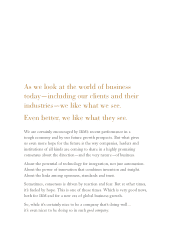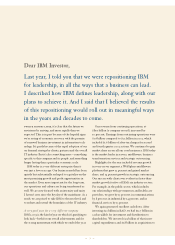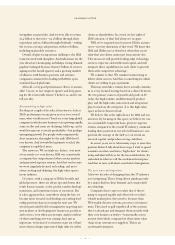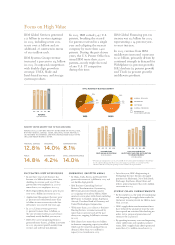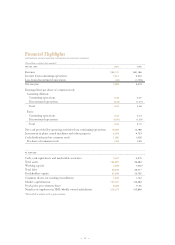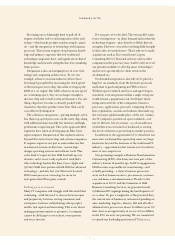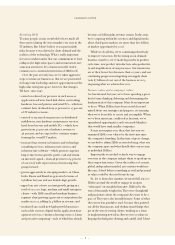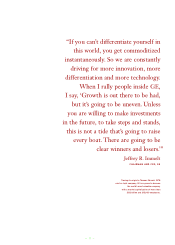IBM 2003 Annual Report Download - page 6
Download and view the complete annual report
Please find page 6 of the 2003 IBM annual report below. You can navigate through the pages in the report by either clicking on the pages listed below, or by using the keyword search tool below to find specific information within the annual report.
4
CHAIRMAN’S LETTER
strengthen our portfolio. And we were able to return
$5.4 billion to investors—$4.3 billion through share
repurchase and $1.1 billion through dividends—ending
the year in a strong cash position, with $7.6 billion,
including marketable securities.
Overall, despite facing serious challenges, the IBM
team executed with discipline. And indications for the
year ahead are encouraging, including a strong demand
pipeline (enlarged by more than $17 billion of services
signings in the fourth quarter) and a growing number
of alliances with business partners and software
companies committed to leading with IBM’s open,
standards-based platforms.
All in all, a very good performance. But is it sustain-
able? Can we, in fact, improve upon it and keep grow-
ing for the foreseeable future? I believe so, and let me
tell you why.
Recommitting to high value
For the past couple of decades, if you were to look at
IBM’s performance in any given year or over several
years, what would you see? You’d see a very large global
company in which some businesses are growing rapidly,
some are flat and some are declining. Add it up, and it
would average out to steady profitability—but perhaps
uninspiring growth. For people with comparatively
short memories, this might be the only IBM they’d
ever known. And it would be legitimate to ask if the
company is capable of more.
The answer is: We certainly are. In fact, over most
of our nearly 100-year history, IBM was consistently
a company that outperformed others in our markets
and generated superior returns. And that was because
we were singularly focused on leading, and most
often creating and defining, the high-value spaces
in our industry.
Of course, with a company of IBM’s breadth and
global presence, there are always ups and downs that
result from economic cycles, product and technology
transitions, and sometimes issues of execution. But
it’s also apparent that, somewhere along the line, we
became more focused on defending our existing lead-
ership position than on creating the next one. We
weren’t particularly bold or imaginative in getting into
new markets or developing new businesses, products
and services, even when our strategic analyses indicat-
ed that something new was coming. And, just as
important, we hesitated to reinvent or get out of busi-
nesses that no longer represented high value for either
clients or shareholders. In a word, we lost sight of
IBM’s mission, of what had always set us apart.
We l l, we’ve regained our focus now. IBM is an inno-
vator—in every dimension of that word. We know that
IBM and IBMers are at their best when they create
value that our clients cannot get from anyone else.
That means we will provide leading-edge technology,
services, expertise and intellectual capital, and will
integrate these capabilities for each client to provide
them with competitive advantage.
We commit to that. We commit to innovating to
deliver client success. And that is something for which
clients are willing to pay a premium.
This may seem like a truism, but it actually commits
us to a very focused strategy, based on a choice between
the two primary sources of growth and profit in IT
today: the high-volume, undifferentiated product
play; and the high-value, innovation and integration
play, focused on the enterprise. It is this high-value
space we have chosen to lead.
We believe this is the right choice for IBM and our
investors. By focusing on this space, we believe we can,
on a sustainable, long-term basis, generate superior
returns compared to the overall IT industry, command
leading share position in our selected businesses, out-
perform the average of the S&P 500 on return on
invested capital, and produce strong cash flows.
In recent years, we’ve taken many steps to seize this
position. Before I talk about those steps, I want to spend
a minute on what constitutes “high value” for clients
today, and what will do so for the foreseeable future. It’s
embodied in what we call the on demand enterprise.
And that, in turn, is all about a new kind of integration.
The next wave of integration
After two decades of disaggregation, the IT industry
is re-integrating. This is being driven simultaneously
by a major shift in client demand, and a major shift
in technology.
Companies have come to realize that if they’re
going to respond rapidly and effectively to today’s
volatile marketplace, they need to do more than
Web-enable discrete systems, processes or business
units. They need to pull together all of the systems
they’ve already got and integrate them securely with
their core business activities—horizontally, across
not just their whole company but their entire value
chain, from customers to suppliers. This is an
on demand enterprise.



